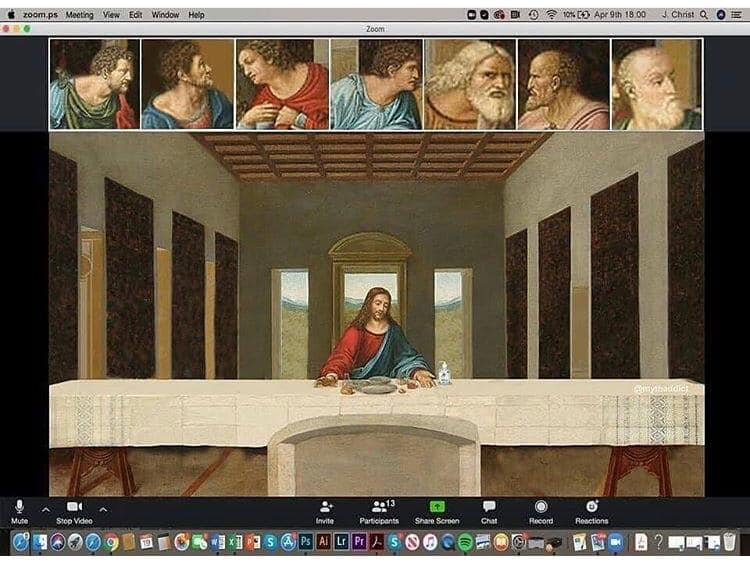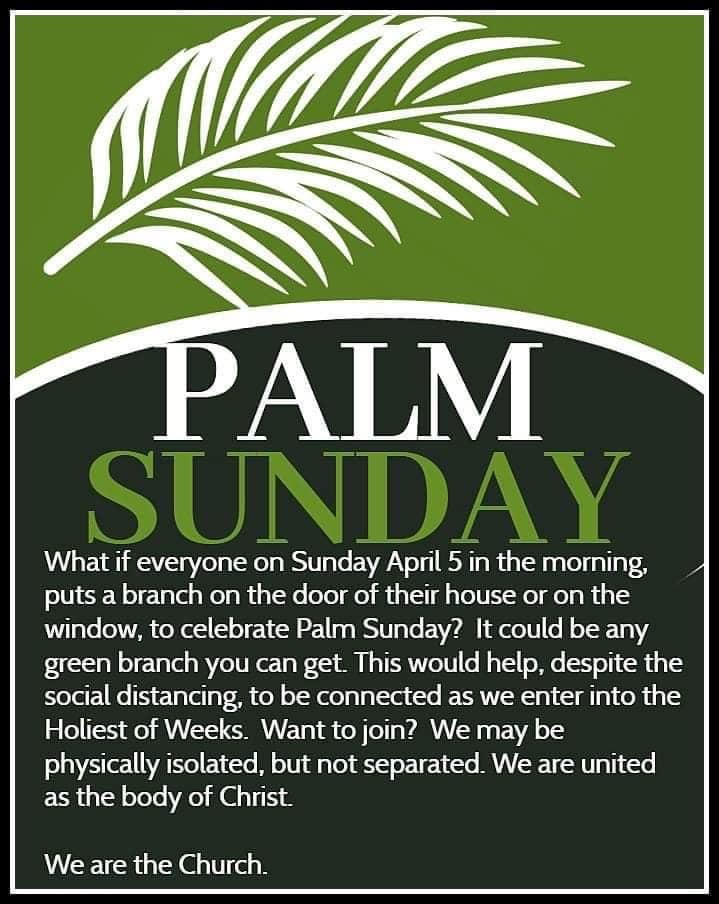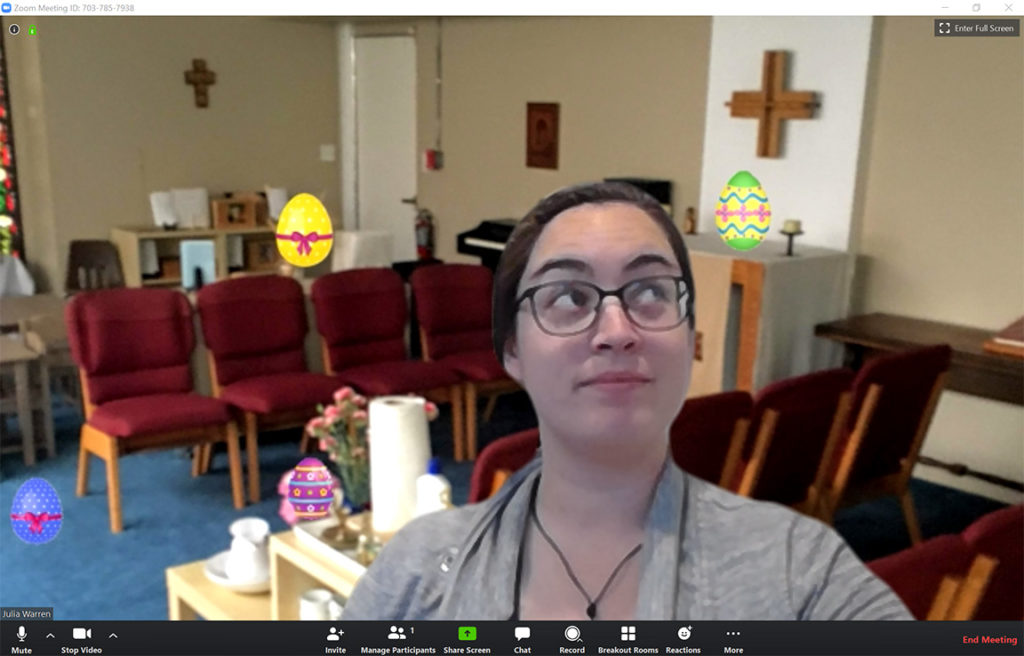
This meme, adapted from Leonardo da Vinci’s famous Last Supper fresco, has been making the rounds on the Internet as congregations honor shelter-at-home orders by shifting Holy Week and Easter worship online. The meme creator is unknown.
Palm Sunday usually jumpstarts Holy Week, with Episcopalians celebrating outside churches, waving palm branches that have been blessed, marching in procession, proclaiming “Blessed is the one who comes in the name of the Lord! Hosanna in the highest” and singing All Glory, Laud and Honor.
However, this Palm Sunday, April 5 — in the age of COVID-19, self-quarantines, stay-at-home orders and shuttered churches — diocesan clergy and congregations will remain outside their buildings through Easter and beyond. But the celebrations will go on.
Southland clergy and congregations are wrestling with ways to lead cyberspace worship during the church’s holiest season. Some are excitedly ramping up for a range of creative possibilities, from an at-home Palm Sunday parade to even hosting a Zoom Easter Egg hunt.
Others’ plans include: using shorter versions of traditional liturgies, offering a “spiritual Eucharist” and filming in backyards and home offices. All have a common aim — to mark the church’s holiest season and to convey safety and reassurance in the midst of extraordinarily uncertain circumstances.
The Bishop’s Liturgical Commission has offered a series of resources to aid diocesan congregations’ celebrations of Holy Week. It also includes directives about acceptable practices and may be found here.

h/t St. Columba’s Church, Camarillo
Palm Sunday — make yourself a parade!
From Costa Mesa to Camarillo, from Beaumont to Oxnard, many plans for Holy Week are still fluid and unfolding, but a roundup of diocesan clergy shared some of their pre-Holy Week hopes and ideas with The Episcopal News.
Invitations have circulated among some congregations for parishioners’ palm-waving ‘selfie’ videos for inclusion in Palm Sunday virtual services. At St. Paul’s Church in Tustin, Sunday school children will be encouraged to stage parades with family members, according to the Rev. Kay Sylvester, rector.
“We are talking about creating at-home activities for Palm Sunday and Easter Sunday,” she said.
St. John’s Cathedral will offer simplified Holy Week services via Facebook Live, from “the cathedral, [which] has been moved to my backyard,” writes the Very Rev. Canon Dan Ade, co-dean.
The services will retain such familiar aspects of Holy Week worship as creating an altar of repose on Maundy Thursday and lighting a new fire Saturday evening to signal the start of a simplified Easter Vigil service.
The Very Rev. Mark Kowalewski, St. John’s co-dean, said prerecorded music will be added to worship. Although worship this year will have a different feel and presentation, Kowalewski said he believes that “People are really appreciative that there is something offered to them and that they like to see us. What’s interesting is we have had a lot more people viewing the service than ever attended services in person.”
In Oxnard, the Rev. Melissa Campbell-Langdell, said “shorter and sweeter” is her plan for Holy Week at All Saints’ Church.
Palm Sunday will be focused “mostly on the palm part,” she said. For Maundy Thursday, she has suggested that All Saints’ members enjoy a simple meal at home and read traditional Scripture together — something a number of churches are also planning to do, she said.
Stations of the Cross will be Zoomed on Good Friday and “we are looking at whether or not we can find a way to have a participatory service — incorporating different parishioners doing the readings,” she said. “I don’t know yet what the technology will be.”
In Beaumont, the Very Rev. Bill Dunn said he is going to try to make his home “look as much like Palm Sunday as we can” for St. Stephen’s parishioners. “We will be in red. I’ll have some palms I’m going to bless. We figure it’s okay to do that,” he said.
While COVID-19 has caused great tragedy, it has also presented great opportunity, he added. “This isn’t necessarily what we wished for, by any means. There is a lot of tragedy because this is a very real, very serious health crisis. But we’re going to come out of this as a church stronger, better connected than we’ve ever been and empowered to really reach out in some ways that we’ve always done. But we’ve got more tools than before, and that is a good thing.”
He said that initial responses to the virtual worship included hesitation, frustration and even some tension. Some parishioners asked such questions as “Is the service really official if we don’t have communion?”
“Of course, the answer is yes,” said Dunn. “We get to be together right now in a virtual way.
“If I sound excited, it’s because I am,” he added. “We’ve been doing this on the fly. This has been for us a real awakening. I never livestreamed before March 15. We’ve reconnected with people who’ve moved away. We’ve heard from folks in North Carolina, Boston, Florida and now, they’re back with us. It’s really cool.”
Meanwhile, the Rev. Amy Pringle, rector of St. George’s, said that the La Cañada church’s worship during the shutdown hasn’t been “a proper service, but more a community get-together. People offer poems, songs and sayings that are helping them through the pandemic, and we end with a prayer and the verbal exchange of peace and love,” Pringle said.
But for Holy Week, she said, “we’ll be sending out links to video meditations that vocational deacon associate Anthony Keller and I have put together for Palm Sunday, Good Friday and Easter.”
The Rev. Greg Frost, rector of the Church of St. Andrew and St. Charles in Granada Hills, hopes to incorporate a green screen to augment his Holy Week videotaping.
“It allows huge flexibility — as soon as I learn how to use it,” he said. “With it, for Palm Sunday I could show images of myself as a person in the crowd, watching Jesus go by on a donkey. For Easter, with the green screen behind me, it can look like I am in Jerusalem.”
While the circumstances may feel challenging and confusing for traditional worshippers, Frost says that they also are full of possibility: “We can be crazy with liturgy.”
But his Easter message will be clear and reassuring: that the stay-at-home directive “helps for people to be safe. But don’t be afraid. Jesus said that a lot. It is easy to panic in times like these, but don’t panic, don’t be afraid. It doesn’t mean things won’t be tough, but we will get through this together.”

Julia Warren, junior warden at St. Mark’s Church, Upland, prepares for a virtual Easter egg hunt via Zoom.
In Costa Mesa, the Rev. George Okusi, rector of St. John’s Church, said he doesn’t want to complicate already-difficult circumstances by adding a lot of confusing changes. He plans to continue what he’s already been doing since Governor Gavin Newsom’s March 19 stay-at-home order — Sunday Zoom church at 10 a.m. and Facebook Live at 11 a.m. on Sundays.
Palm Sunday will be a bit different because Bishop John Harvey Taylor recently allowed healthy organists under 65 to play or record music at church, with proper sanitizing and distancing. “Our organist will come and play two songs,” said Okusi. “I will offer a sermon and conclude with prayer. I also maybe will have a shorter version for YouTube and send it out for our members.”
The Rev. Julie Morris, pastor of Mount Cross Lutheran Church in Camarillo said she plans to “stay as close to the traditional liturgies as possible, but understanding it is such a different time.” She and the Very Rev. Greg Larkin, rector of St. Columba’s in Camarillo have planned to do the Good Friday liturgy together via Facebook.
“Greg will do as a sermon a creative story about Nicodemus,” said Morris, an Episcopal priest who leads the Lutheran congregation under the two denominations’ shared communion concordat. “It’ll be first person and will be livestreamed on our Facebook page.”
The Rev. Fennie Hsin-Fen Chang, vicar of St Thomas’ Church in Hacienda Heights, said she’s received great ideas from resources offered by the diocese. “We’ve been offering worship on Facebook Live since March 16 and will continue throughout Holy Week,” she said.
“The tradition is that we meet every weekday in Holy Week. The first three days, lay people would usually take turns leading the prayer service, but this time I may just have to do it myself because not everyone is comfortable using Facebook and livestreaming.”
For others, like the Very Rev. Jeannie Martz, online worship has felt like “a technological stretch.” Consequently, Martz, rector of Trinity Church in Orange, said this year’s observances “will be a bit understated.
“Our strength is not technology as much as relationship. We are concentrating on telephone trees, with everybody calling everybody. In terms of [online] worship, we have been referring folks to the Washington National Cathedral, to Bishop John (Harvey Taylor) or to Mission St. Claire,” she said. While plans for Trinity’s Holy Week worship were still fluid, she said for sure they will recall the church’s rich history of Taizé-inspired services.
“One thing we’ve historically done that folks have loved is a candlelight Taizé service on Tuesday evening in Holy Week. We have it recorded and we will put it on Facebook at the time we would normally hold that service,” she said.
“We are trying to play to our strengths, to what’s good in the community and to keep it going, in the sense of relationship we’re all in touch, we’re in it together and we’ve been learning some new skills.”
A Spiritual Eucharist
Holy Week at St. Francis Church, Rancho Palos Verdes, will continue to incorporate the “Spiritual Eucharist” that the Very Rev. Paula Vukmanic began on March 29.
It involves a liturgy but, in place of the Eucharist, “I hold up an empty chalice and paten,” she said. Accompanying the empty chalice and paten is a prayer offered by Presiding Bishop Michael B. Curry, by way of Washington National Cathedral. “It has felt very powerful.”
Good Friday’s Stations of the Cross will include images of the church’s own past challenges. “We have stations from the broken glass of the 1994 Northridge earthquake,” Vukmanic said. “These broken pieces are inside of a frame, so you can literally see the air around the broken pieces of glass that used to be our stained-glass windows.”
Vukmanic and three other artists dripped liquid lead, to add images of Christ to each station; they hang from chains at different levels. They will be the only images people see during the online Stations of the Cross, she said.
On Holy Saturday, the Easter Vigil will be “absolutely simplified. We’re not going to light a fire or do the Exultet. We’re going to focus on, we have a salvation history and it led to the full story of God in Jesus and tonight we are the resurrection people at St. Francis and Alleluia.”
For the Rev. Kay Sylvester, however, there can be no alleluias said at St. Paul’s Church in Tustin, not until the community enjoys in-person worship again.
Sylvester is producing an I-Movie for the Easter Vigil that will include prerecorded readings.“I will introduce baptism, pour water in the font, renew our vows, all of that. But I will eliminate the Alleluia and obviously, I’m not going to have communion.
“It will conclude with me saying ‘it won’t be Easter until we’re all together. We’ve told the story. We’ve reached the calendar moment. We’re not to Easter yet. We are still in a period of waiting.’ We’re going to have Easter when we get together again.”
She said members of her congregation “are worried about Holy Week, that we’re going to go too far in terms of not acknowledging the moment we’re in. I feel this is the right choice for my community,” she said. “We can’t wait to be together again. We can’t wait to hug people again. We can’t wait to have communion again. We are praying for all of us. There are a lot of unprecedented choices to make, and our own grief to deal with.”
For a lift-your-spirits Easter Sunday celebration, Julia Warren, the junior warden at St. Mark’s Church in Upland, is suggesting a virtual Easter Egg hunt for the young and young-at-heart.
“We were trying to figure out a way to still engage our younger audience and capture the spirit of the Easter Egg Hunt we hold annually,” according to Warren. “As we continued to learn about Zoom’s “Virtual Background” feature, combined with everyone’s tendency to intentionally place objects of significance in view of their cameras during Zoom meetings, we thought, why couldn’t we hide Easter eggs this way?
“Using free image editing software and existing images of our St. Mark’s Campus, I started hiding Easter eggs. Our hope is to get enough parishioners on Zoom to use virtual or real background that contain hidden Easter eggs to hold a virtual egg hunt this year.”
The Rev. Canon Pat McCaughan, vicar of St. George’s Church, Laguna Hills, is senior correspondent for The Episcopal News.
